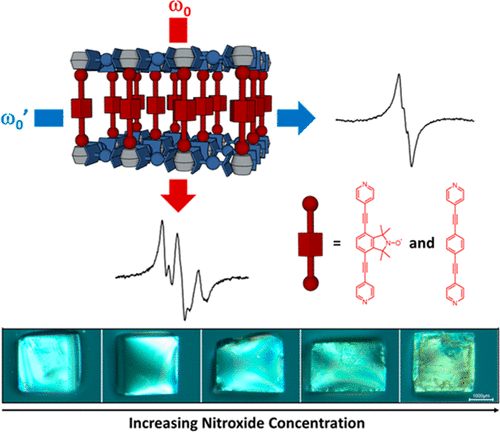当前位置:
X-MOL 学术
›
J. Am. Chem. Soc.
›
论文详情
Our official English website, www.x-mol.net, welcomes your
feedback! (Note: you will need to create a separate account there.)
2D Arrays of Organic Qubit Candidates Embedded into a Pillared-Paddlewheel Metal-Organic Framework
Journal of the American Chemical Society ( IF 14.4 ) Pub Date : 2020-09-25 , DOI: 10.1021/jacs.0c07251 Marcus J. Jellen 1 , Mayokun J. Ayodele 2 , Annabelle Cantu 1 , Malcolm D. E. Forbes 2 , Miguel A. Garcia-Garibay 1
Journal of the American Chemical Society ( IF 14.4 ) Pub Date : 2020-09-25 , DOI: 10.1021/jacs.0c07251 Marcus J. Jellen 1 , Mayokun J. Ayodele 2 , Annabelle Cantu 1 , Malcolm D. E. Forbes 2 , Miguel A. Garcia-Garibay 1
Affiliation

|
The creation of ordered arrays of qubits that can be interfaced from the macroscopic world is an essential challenge for the development of quantum information science (QIS) currently being explored by chemists and physicists. Recently, porous metal-organic frameworks (MOFs) have arisen as a promising solution to this challenge as they allow for atomic-level spatial control of the molecular subunits that comprise their structures. To date, no organic qubit candidates have been installed in MOFs despite their structural variability and promise for creating systems with adjustable properties. With this in mind, we report the development of a pillared-paddlewheel-type MOF structure that contains 4,7-bis(2-(4-pyridyl)-ethynyl) isoindoline N-oxide and 1,4-bis(2-(4-pyridyl)-ethynyl)-benzene pillars that connect 2D sheets of 9,10-dicarboxytriptycene struts and Zn2(CO2)4 secondary binding units. The design allows for the formation of ordered arrays of reorienting isoindoline nitroxide spin centers with variable concentrations through the use of mixed crystals containing the secondary 1,4-phenylene pillar. While solvent removal causes decomposition of the MOF, magnetometry measurements of the MOF containing only N-oxide pillars demonstrated magnetic interactions with changes in magnetic moment as a function of temperature between 150 and 5 K. Variable-temperature electron paramagnetic resonance (EPR) experiments show that the nitroxides couple to one another at distances as long as 2 nm, but act independently at distances of 10 nm or more. We also use a specially designed resonance microwave cavity to measure the face-dependent EPR spectra of the crystal, demonstrating that it has anisotropic interactions with impingent electromagnetic radiation.
中文翻译:

嵌入柱状叶轮金属有机框架的有机量子位候选物的二维阵列
创建可以与宏观世界接口的有序量子位阵列是目前化学家和物理学家正在探索的量子信息科学 (QIS) 发展的一项重要挑战。最近,多孔金属有机框架 (MOF) 已成为应对这一挑战的有希望的解决方案,因为它们允许对构成其结构的分子亚基进行原子级空间控制。迄今为止,尽管 MOF 具有结构可变性并有望创建具有可调节属性的系统,但尚未在 MOF 中安装任何有机量子位候选者。考虑到这一点,我们报告了包含 4,7-双(2-(4-吡啶基)-乙炔基)异吲哚啉 N-氧化物和 1,4-双(2-( 4-吡啶基)-乙炔基)-苯柱,连接 9 个 2D 片材,10-dicarboxytriptycene 支柱和 Zn2(CO2)4 二级结合单元。该设计允许通过使用包含次要 1,4-亚苯基柱的混合晶体,形成具有可变浓度的重新定向的异二氢吲哚氮氧化物自旋中心的有序阵列。虽然溶剂去除会导致 MOF 分解,但对仅包含 N 氧化物柱的 MOF 的磁力测量表明,在 150 到 5 K 之间,磁矩随温度的变化而变化。变温电子顺磁共振 (EPR) 实验表明氮氧化物在长达 2 nm 的距离内相互耦合,但在 10 nm 或更长的距离内独立作用。我们还使用专门设计的共振微波腔来测量晶体的面相关 EPR 光谱,
更新日期:2020-09-25
中文翻译:

嵌入柱状叶轮金属有机框架的有机量子位候选物的二维阵列
创建可以与宏观世界接口的有序量子位阵列是目前化学家和物理学家正在探索的量子信息科学 (QIS) 发展的一项重要挑战。最近,多孔金属有机框架 (MOF) 已成为应对这一挑战的有希望的解决方案,因为它们允许对构成其结构的分子亚基进行原子级空间控制。迄今为止,尽管 MOF 具有结构可变性并有望创建具有可调节属性的系统,但尚未在 MOF 中安装任何有机量子位候选者。考虑到这一点,我们报告了包含 4,7-双(2-(4-吡啶基)-乙炔基)异吲哚啉 N-氧化物和 1,4-双(2-( 4-吡啶基)-乙炔基)-苯柱,连接 9 个 2D 片材,10-dicarboxytriptycene 支柱和 Zn2(CO2)4 二级结合单元。该设计允许通过使用包含次要 1,4-亚苯基柱的混合晶体,形成具有可变浓度的重新定向的异二氢吲哚氮氧化物自旋中心的有序阵列。虽然溶剂去除会导致 MOF 分解,但对仅包含 N 氧化物柱的 MOF 的磁力测量表明,在 150 到 5 K 之间,磁矩随温度的变化而变化。变温电子顺磁共振 (EPR) 实验表明氮氧化物在长达 2 nm 的距离内相互耦合,但在 10 nm 或更长的距离内独立作用。我们还使用专门设计的共振微波腔来测量晶体的面相关 EPR 光谱,











































 京公网安备 11010802027423号
京公网安备 11010802027423号